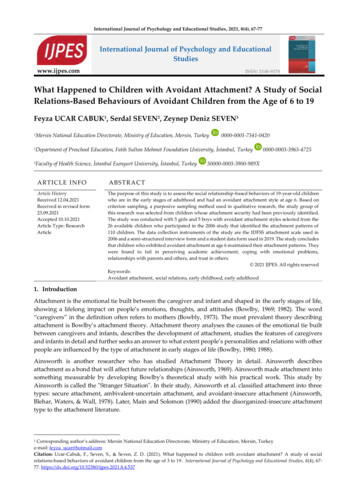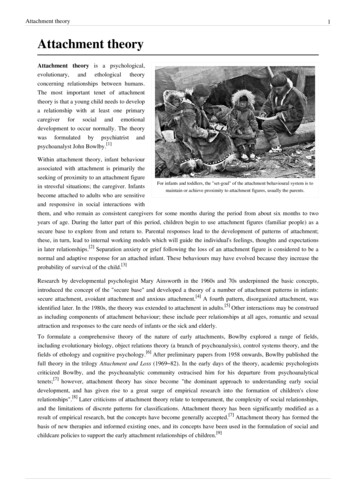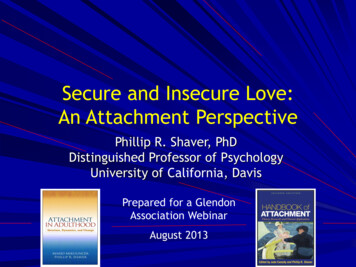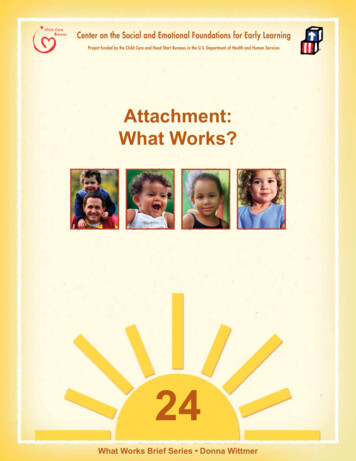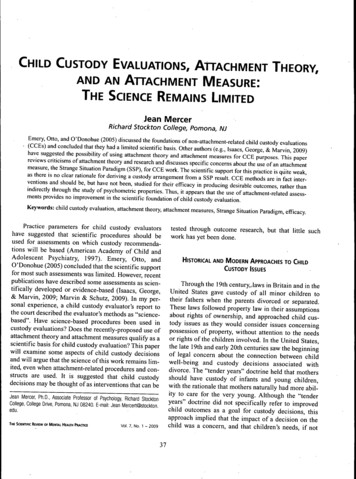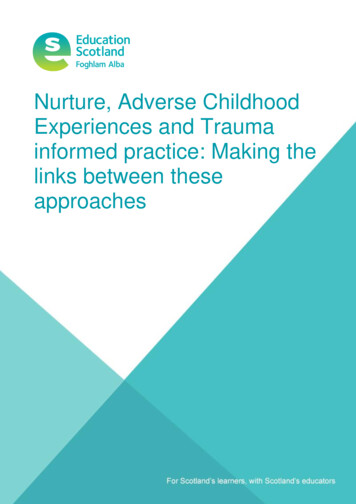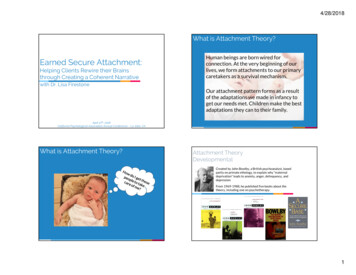
Transcription
4/28/2018What is Attachment Theory?Earned Secure Attachment:Helping Clients Rewire their Brainsthrough Creating a Coherent NarrativeHuman beings are born wired forconnection. At the very beginning of ourlives, we form attachments to our primarycaretakers as a survival mechanism.with Dr. Lisa FirestoneOur attachment pattern forms as a resultof the adaptations we made in infancy toget our needs met. Children make the bestadaptations they can to their family.April 27th, 2018California Psychological Association Annual Conference – La Jolla, CAWhat is Attachment Theory?Attachment TheoryDevelopmentalCreated by John Bowlby, a British psychoanalyst, basedpartly on primate ethology, to explain why “maternaldeprivation” leads to anxiety, anger, delinquency, anddepressionFrom 1969-1988, he published five books about thetheory, including one on psychotherapy.1
4/28/2018Attachment Theory and ResearchBowlby contended that internal working models ofattachment help to explain: Emotional distress Personality disturbance Emotional detachment“Attachment underlies later capacity to make effectualbonds as well as a whole range of adult dysfunctions,”particularly with marital bonds and trouble parenting.Attachment Theory Distilled Humans, especially youngchildren, rely on attachmentfigures for protection,support, and emotionregulation The attachment behavioralsystem is an evolved, innateregulator of proximity (henceof safety and safe exploration)From “Attachment Theory and Research: Implications for Psychodynamic 0.1007%2F978-1-60761-792-1 24#page-1Attachment Theory Distilled When threats abate, behavioralsystems other than attachment (e.g.,exploration, caregiving) can beactivated, allowing a person to becomemore competent/ autonomous Attachment orientations, or “styles,”develop in relationships, resulting insystematic individual differences inattachment orientation: secure,anxious, avoidant. . . The theory applies from “the cradle tothe grave” (Bowlby)Attachment Theory Distilled Our attachment system is activated when we are distressed. The way our parents interact with us (particularly duringtimes of distress) forms the basis of our attachment style.2
4/28/2018Attachment Theory DistilledHumans rely onattachment figures for: Protection (safesafe)safe Support (seenseen)seen Emotion regulation (soothedsoothed)soothedReasons Why it’s Important toKnow about Attachment Style You assess the patient’s attachment style,because it influences the process ofpsychotherapy, the quality of the alliance andthe ultimate outcome of treatment. Provides clues as to how the patient is likely torespond in treatment and to the therapist.From “Attachment /jclp.20756/abstract;jsessionid ssCustomisedMessage &userIsAuthenticated falsePsychotherapy Relationship as AttachmentPsychotherapy relationship with an adult client exhibits all theessential elements of attachment bonds: They regard their therapist as stronger and wiser.Patterns of Attachment They seek proximity through emotional connection andregular meetings. They reply upon the therapist as a safe haven when they feelthreatened. They derive a sense of felt security from their therapist whoserves as a secure base for psychological exploration. They experience separation anxiety when anticipating loss oftheir therapist.From “The Psychotherapy Relationship as blication/232509555 Attachment patterns in the psychotherapy relationship Development of the Client Attachment to Therapist Scale/file/72e7e52b89f8021b12.pdf3
4/28/2018We have different attachments todifferent people Measuring AttachmentMotherThe Strange SituationThe Adult AttachmentInterviewFatherAuntor UncleGrandparentPatterns of Attachment in ChildrenAttachment Style SecureInsecure – avoidantPatterns of Attachment in ChildrenParental Interactive Pattern Emotionally available,perceptive, responsiveEmotionally unavailable,imperceptive, unresponsiveand rejectingAttachment Style Parental Interactive PatternInsecure – anxious/ ambivalent Insecure – disorganized Inconsistently available,perceptive and responsive andintrusiveFrightening, frightened,disorienting, alarming4
4/28/2018Attachment FiguresLow Risk NonNon-Clinical Populations Secure5555-65% Ambivalent5-15% Avoidant2020-30% Disorganized2020-40%(Given a Best Fit Alternative)High Risk, Parentally maltreated Disorganized80%What causes insecure attachment?Unresolved trauma/loss in the life of the parentsstatistically predict attachmentstyle far more than:Secure Attachment Promotes Flexible self-regulationProsocial behaviorEmpathyPositive sense of emotionalwell-being and self-esteem Coherent life-storyImplicit Versus Explicit MemoryImplicitMemoryExplicitMemory Maternal Sensitivity Child Temperament Social Status Culture5
4/28/2018The Brain in the Palm of Your HandDaniel Siegel, M.D. – Interpersonal Neurobiology9 Important Functions ofthe Pre-Frontal Cortex1.2.3.4.5.6.Body RegulationAttunementEmotional BalanceResponse FlexibilityEmpathySelf-Knowing Awareness(Insight)7. Fear Modulation8. Intuition9. MoralityMaternal caregiving at 18 months predicts selfreported anxiety and avoidance at age 22(Zayas, Mischel, Shoda, & Aber, SPPS, 2010)A 1000-page summaryof basic and appliedattachment theory andresearch From: “Secure and Insecure Love: An Attachment Perspective” Phillip R. Shaver, Ph.D.When each of 36 children were 18 months old, they were observed in a preschoolplayroom at Stanford University with their mother, and her behavior was reliablycoded on three observational scales: sensitive, controlling, and unresponsive.At 22 years of age, the now-grownup children completed a short version of the ECR asa measure of attachment anxiety and avoidance in romantic and self-motherrelationships.Attachment anxiety at age 22 correlated -.75 with maternal sensitivity measured 20years earlier, and .70 with maternal controlling. Avoidance at age 22 correlated -.73with maternal sensitivity and .52 with maternal controlling.These correlations were much higher than similar correlations with self-reportedattachment to mother at age 22.From: “Secure and Insecure Love: An Attachment Perspective” Phillip R. Shaver, Ph.D.6
4/28/2018Adult Attachment Styles:Regions in a 2-Dimensional SpaceSelf-Report Attachment Measure(Brennan, Clark, & Shaver, 1998)HIGH AVOIDANCEAvoidance (18 items, α .90).90)1.2.3.4.FEARFUL AVOIDANTDISMISSING AVOIDANTLOW ANXIETYHIGH ANXIETYI prefer not to show a partner how I feel deep down.I try to avoid getting too close to my partner.I feel comfortable depending on relationship partners. (reverse-scored)I turn to a relationship partner for many things, including comfort andreassurance. (reverse-scored)Anxiety (18 items, α .90)1.2.3.4.SECUREI don’t often worry about being rejected or abandoned. (reverse-scored)I need a lot of reassurance that I am loved by a partner.I get frustrated if a relationship partner is not available when needed.I resent it when a partner spends time away from me.PREOCCUPIEDLOW AVOIDANCEFrom: “Secure and Insecure Love: An Attachment Perspective” Phillip R. Shaver, Ph.D.Adapted from Ainsworth et al. (1978), Bartholomew & Horowitz (1991), Fraley & Shaver (2000)From: “Secure and Insecure Love: An Attachment Perspective” Phillip R. Shaver, Ph.D.Overall ConclusionsAttachment and CaregivingMany studies have shown thatattachment anxiety andavoidance are related todeficits in caring forrelationship partners andengaging in altruistic behaviormore generally (e.g., Kunce &Shaver, 1994; Gillath et al.,2005).Anxious people tend to beself-focused when engagedin supposedlycaring/altruistic actions,leading to intrusiveness,poor assessment of others’actual needs, and personaldistress.Avoidant people tend tobe less interested inhelping others and toderogate needy others.They are relativelydeficient in the domainof compassion and love. Attachment theory has proven to be a very fruitful framework forstudying social and psychological processes Our priming studies show that security infusions, whetheradministered consciously or subliminally, have beneficial effects onmental health and interpersonal relations This suggests that insecurity lies at the heart of many psychologicaland social pathologies (as Bowlby suspected from the beginning) Similar mental and social processes occur in different contexts:romantic relationships, teacher-student relationships, leaderfollower relationships, etc.; and many attachment-related mentalprocesses occur in religious/spiritual contexts (prayer, meditation) Humans’ social-relational nature shows up everywhere andperhaps can eventually be conceptualized in a general theoryFrom: “Secure and Insecure Love: An Attachment Perspective” Phillip R. Shaver, Ph.D.7
4/28/2018Since Hazan & Shaver (JPSP, 1987) Strategies for Developing More Secure AttachmentsHundreds of studies using selfreport attachment measureshave been conductedStrategies for Success in Developing More Secure AttachmentsWhy is it important to make sense of your life?Developing a Secure AttachmentResearch shows that with self-reflection and understanding, we can free ourselves from thelimitations of our upbringing.Making sense of our lives by writing a coherent narrative allows us to have a sense of who we’vebeen, who we are now, and who we’d like to become.““Research reveals that the more coherent a narrative we have of our ownattachment issues in childhood, the more we’ve made sense of how our earlylife experiences have shaped us, the more likely our children will have a secureattachment to us and the more rewarding in general our interpersonalrelationships will be.” Dr. Dan Siegel“When we create a narrative of who we are, we link pastand present so we can become the active author of apossible future, too.” Dr. Dan Siegel It is never too late to develop an Earned Secure Attachment.Models of attachment are changeable, but only if we come tounderstand them. Feel the full pain of your childhood and make sense of it. Grow toward security by developing integration from nonintegrated brain functioning. Because our attachment ability is broken in a relationship, it can befixed in a relationship. This can be with a romantic partner, a closefriend or a good therapist. It takes time to develop an EarnedSecure Attachment in a relationship. Stick with it!8
4/28/2018Questions for Self-ReflectionsThe following questions are designed for self-reflection, guiding you to think about your early lifeexperiences. These questions were adapted from Dr. Dan Siegel’s book Brainstorm. In your journal, writeresponses to each of the following questions. Your responses can be as long or as short as you like.Looking Back on Your Early RelationshipsChoose five adjective s or words that reflect your relationship with your mother or mother-likefigure. Try to think back as far as you can remember to your early childhood.Now, try to think of a memory or an incident that would illustrate each of the words you chose todescribe the relationship. Write these memories or incidents down. Family BackgroundWho was in your family? Include significant adults, siblings, etc.What was it like growing up in your family?What was your parents’ philosophy about raising children?Adjective 1:Memory : Family Relationships and AttachmentWas there anyone in your life, other than your parents, who served as a parental figure or to whom youfelt attached? Please state a few words to reflect your relationship with those individuals as well.What were the major conflicts in your family? Did you have conflict with anyone?Was there anyone you could turn to or any place you could go to help you feel comforted during difficulttimes? Childhood ExperiencesDid you ever experience a long separation from your parents in childhood? What was that like for you?How were you disciplined as a child?Have you ever felt threatened by your parents?Have you ever felt rejected by your parents?Adjective 2:Memory :Adjective 3:Memory :Adjective 4:Memory :Adjective 5:Memory :Reflect on Your Attachment ModelsForming a Story: The Health Benefits of NarrativeLook over your responses to the“Questions for Self-Reflection”and “Look Back on Your EarlyRelationships” exercises. As youread through your responses,think about the attachment modelor models you have experiencedin your life. Were they secure,avoidant, ambivalent, and/ordisorganized? Remember, manyof us have experienced more thanone of these attachment models.Keep in mind that, as Dr. DanSiegel writes in Brainstorm,“Your attachment model is asummary of how you’ve adaptedto the relationships you’ve hadwith the important people inyour life. It’s not however, a signof some problems to have insideyou – it’s merely a reflection of alearned response to real-lifeevents, to your actualrelationship in your early days.”We invite you to reflect onyour attachment models inyour journal. Consider howyour early relationships andthe attachment models youdeveloped in responseshape how you connectwith others today. James Pennebaker & Janel Seagal, Journal of Clinical Psychology, 1999““Writing about personal experiences in an emotional way for as little as 15minutes over the course of three days brings about improvements in mental andphysical health.”“ writing serves the function of organizing complex emotional experiences.”“ the formation of a narrative is critical and is an indicator of good mental andphysical health.”“Forming a story about one’s experiences in life is associated with improvedphysical and mental health across a variety of populations.”9
4/28/2018Tips for Writing a Coherent NarrativeToolkit Write as an adult. Write rationally. Name It to Tame It Write autobiographically. Wheel of Awareness Write intuitively. RAIN Approach Write with feeling. Write about how the past influences your present. Balancing the Mind Write with balance. Strengthen Your Internal Observer Write with selfself-compassion.The RAIN ApproachIdentifying TraumasList some emotional or physical traumas or traumatic events that have happened in your life.These do not have to be “Big T” traumas. A trauma can be any significant, distressing eventor incident that shaped you as a child – things that made you feel bad, scared, ashamed, etc. entificationNon1.2.3.4.5.6.7.8.9.10.10
4/28/2018Understanding for TriggersChoose Your WordsChoose from the descriptive list given below andpick the word that best describes the deeperemotion that comes up when you get triggeredemotionally. This is often some kind of fearabout yourself or how others feel about you. Itmay be some kind of anguish or hurt.How Elements from our Past Trigger Us in the PresentLonelyDismissed andUnimportantFrustrated and HelplessOn Guard tedThreatenedPanickedRejectedLike I Don’t MatterIgnoredInadequateShut Out and AloneConfused and DisappointedIsolatedLet DownNumbHumiliatedOverwhelmedSmall or InsignificantUnwantedVulnerableWorriedSource: Johnson, Sue. Hold Me Tight: Seven Conversations for a Lifetime of Love. Little Brown & Co, 2011.Think about a recent time that you got triggered Practice Integrating Your BrainHow did you feel at the time?What event or feeling in your childhood do you think led youto feel triggered in the recent situation?Write a story that makes sense out of why you felt triggered.Mindfulness helps integrate the brainfor all attachment patterns.11
4/28/2018Interpersonal NeurobiologySelf-Compassion“Being touched by and not avoiding your suffering”C uriousO penA cceptingL oving“From Kristin Neff:Self-compassion is not based on self-evaluation. It is not a way ofjudging ourselves positively; it is a way of relating to ourselves kindly.Three Elements:1. Self-kindness Vs. Self-judgment2. Mindfulness Vs. Over-identification with thoughts3. Common humanity Vs. IsolationSOURCE: http://www.self-compassion.org/Practice Integrating Your BrainPractice Integrating Your BrainAvoidant Attachment:Anxious/Ambivalent Attachment: Become aware of non-verbal signals. Try watching TVwithout the sound on. Cultivate the ability to name your internal emotional states(“name it to tame it”). Simply describe what you feel, youdon’t need to explain it. Build autobiographical memories. Write down the details ofwhat you did today. Pay attention to any desires you have to be closer to peoplein your life. Reach out to another person to express yourfeelings of wanting to connect. Write in a journal. Use your left hemispheres drive to tell alogical, linear, language-based story. Pay attention to when your attachments system goes intooverdrive. Focus on keeping an internal state of calm atthese times.12
4/28/2018Practice Integrating Your BraineCourseDisorganized Attachment: Keep a journal and be sure to write about times when youfeel triggered or your internal world may feel fragmented. When investigating your past, try to use the RAIN approach:recognize the trauma or loss, accept that it has occurred andmay be in a state of being unresolved, investigate the natureof the experience in our past and present lives, and havenon-identification with the experiences (meaning the eventsdon’t define you). SIFT. Pay attention to your sensations, feelings, thoughtsand images, as they arise.Sign up today!visit www.psychalive.org for a full list of online coursesDevelop Security in PsychotherapyTreatmentPsychotherapy is an excellent vehicle to develop anearned secure attachment.Find a therapist that resonates with you. Stay intherapy for two to five years.13
4/28/2018The making and breaking of affectional bonds. II. Someprincipals of psychotherapy. The Fiftieth Maudsley LectureAttachment Theory-Based Interventions John Bowlby, BJPsych, 1977““ a psychotherapist is seen to have a number of inter-relatedtasks: (a) to provide the patient with a secure base from which he, thepatient, can explore himself and his relationships; (b) and (c) toexamine with the patient the ways in which he tends to construecurrent interpersonal relationships, including that with the therapist,and the resulting predictions he makes and actions he takes, and theextent to which some may be inappropriate; (d) to help him considerwhether his tendencies to misconstrue, and as a results to actmisguidedly, can be understood by reference to the experiences hehad with the attachment figured during his childhood ”Most existing therapies use techniques and principlesthat are in line with attachment theory.For example, healthy therapeutic relationships,exploration of significant relationships in past.From “Attachment Theory and Research: Implications for Psychodynamic 0.1007%2F978-1-60761-792-1 24#page-1Implication of Attachment Theory for TreatmentA Few of Many Clinically-Oriented BooksBased Partly on Shaver’s Research Behavioral and family systems therapies focus on making proceduralmemories conscious and available for inspection.Cognitive therapies focus on changing family semantic generalizations.Psychodynamic therapies focus on retrieval of forgotten episodicmemories in order to process them through to resolution.Meditative therapies emphasize the need to attain distance fromdistressing life events in order to achieve integration.Psychotherapy promotes self-understanding by illuminating how clients’internal working models as opposed to external forces are what shape thepresent quality of their interpersonal relationships. Johnson, S. (2008). Hold me tight: Seven conversations for alifetime of love. New York, NY: Little, Brown.Johnson, S. (2013). Love sense: The revolutionary new science ofromantic relationships. New York, NY: Little, Brown.Levine, A., & Heller, R. (2010). Attached: The new science of adultattachment and how it can help you find – and keep – love. NewYork, NY: Tarcher/Penguin.Marmarosh, C. L., Markin, R. D., & Spiegel, E. B. (2013). Attachmentin group psychotherapy. Washington, DC: American PsychologicalAssociation.Obegi, J. H., & Berant, E. (Eds.) (2008). Attachment theory andresearch in clinical work with adults. New York, NY: Guilford Press.From “The Role of Adult Attachment Styles in Psychopathology and Psychotherapy Outcomes”http://cmapspublic2.ihmc.us/rid 1LQRRMMH0-FYYR87-1L42/pdf.pdf14
4/28/2018Upcoming WebinarsAlbert Einstein““A human being is a part of a whole, called by us 'universe', a partlimited in time and space. He experiences himself, his thoughts andfeelings as something separated from the rest. a kind of opticaldelusion of his consciousness. This delusion is a kind of prison for us,restricting us to our personal desires and to affection for a fewpersons nearest to us. Our task must be to free ourselves from thisprison by widening our circle of compassion to embrace all livingcreatures and the whole of nature in its beauty. Nobody is able toachieve this completely, but the striving for such achievement is initself a part of the liberation and a foundation for inner security."Archived CE WebinarsMay 16thAugust 20thBreaking Bad Habits: TheNeuroscience and Psychologyof Personal TransformationThe Science and Practice ofPresence with Dr. Daniel SiegelJune 4thHow to Outsmart Panic Attacksvisit www.psychalive.org for a full list of upcoming webinarsDan Siegel ResourcesWatch CE Webinars online at your conveniencefeaturing expert presenters that include:Dr. Daniel SiegelDr. Donald MeichenbaumDr. James GilliganDr. Pat LoveDr. Lisa FirestoneDr. Sheldon SolomonDr. Christine Courtoisand more visit www.psychalive.org for a full list of archived webinarswww.drdansiegel.com15
4/28/2018Resources: BooksContact: Glendon@Glendon.org or (800) 663-5281Lisa Firestone, Ph.D.Director of Research and EducationThe Glendon Associationlfirestone@glendon.orgSenior EditorPsychAlive.orgvisit www.psychalive.org for resource linksTHE GLENDONASSOCIATION(For Professionals)www.glendon.org(For the Public)www.psychalive.org16
From: "Secure and Insecure Love: An Attachment Perspective" Phillip R. Shaver, Ph.D. A 1000-page summary of basic and applied attachment theory and research When each of 36 children were 18 months old, they were observed in a preschool playroom at Stanford University with their mother, and her behavior was reliably
